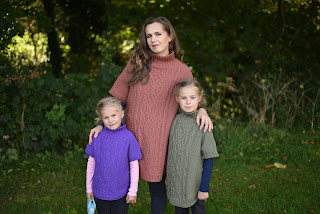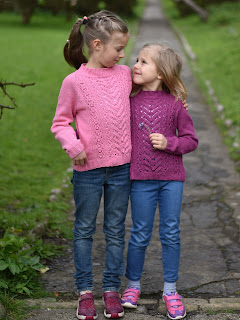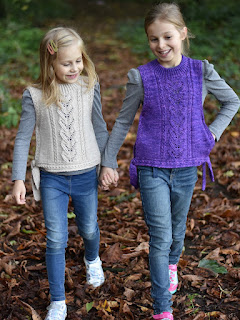The yarn choice is a crucial factor in any project, dependent on various factors such as the season, your concept, fibre preference, pattern recommendations, and the budget. The simplest way to ensure the right yarn for your project is to choose the one recommended in the pattern. However, this isn't always possible for reasons like yarn availability in your country, price, limitation of colours, etc. Let's explore how to find suitable yarn for your project based on quality and appropriateness.
Yarn Weight (Thickness)
If you are looking the yarn for particular pattern, then this step is answered. You must follow the designer recommendation for yarn’s type to achieve a great result. In other words, if your patten calls for DK weight yarn, then find suitable DK yarn, otherwise you wouldn’t be able to get the correct gauge and your finished item would be smaller or bigger than needed.
Note: Those three ponchos are knitted in Aran weight yarn with different fibre combination or wool type from three different brands. For one of those ponchos I had to adjust the knitting needles size to get the correct gauge. Patterns Cable Fantasy poncho and Adult Cable Fantasy poncho
In one of my previous posts you can find useful information how to check your knitting gauge (tension) correctly and what to do if it does not match the recommended in the pattern - check them out here.
However, if you are looking for the yarn for your own idea you have bigger choice and do not have to stick with a particular thickness of yarn. Your choice is much bigger.
When considering yarn weight, think about when and how you'll wear your garment. Are you going to wear your garment next to skin? Will it be a second layer over a long sleeve top or shirt? May be you need a bulky or super chunky yarn for extra warm piece to replace a jacket or lightweight coat.

Fingering/4-ply, sport/5-ply, and DK/8 ply yarns in plant-based fibre or wool blend create excellent garments and accessories for spring/summer as well as early autumn. Thicker woolly yarns in DK, worsted, Aran, or bulky weight are perfect for winter. If you need something in between those gauges you can always add a strand of lace weight yarn such as mohair to your main yarn and knit them together. This method is also helps to create new colours without dyeing of your yarn.
Note: Statice shawl is knitted with strand of DK weight yarn hold together with strand of mohair yarn in contrast colour.
Materials and fibre content
If you aim to enjoy your knitted garment for years, I recommend opting for yarn made with natural fibres or a wool blend with a minimal percentage of nylon, unless there's a specific reason for using artificial fibres like acrylic. There are options available for every budget in the market.
For a universal garment suitable for any season, consider mixed yarns like cotton-wool, wool-viscose, or wool-silk blends. These combinations provide a great balance, not too warm yet perfect for chilly evenings and unexpected windy days in summer.
For colder seasons, choose warmer yarns such as alpaca, merino, Shetland, angora, cashmere, and others, available in various weights.
However, if you are looking the great yarn for a pair of socks, then at least 15% of synthetic such as polyamide or nylon in it's fibre content is must. Otherwise your socks will wear out way too fast. Do not be tricked by yarn description "sock yarn", always check the fibre content!
Note: D-light sweater is knitted with 85% of cotton and 15% off cashmere yarn, which makes it perfect garment for any season.
Choosing the Perfect Colour
Picking the right colour is crucial but tricky. A well-chosen colour enhances your enjoyment of the garment, while the wrong one might relegate it to the depths of your closet. Take time to think about the design and plan how you'll style your future garment.
Bright, vibrant shades lift dull days, while neutral or pastel colours provide extra cozy moments. Hand-dyed yarn from indie dyers offers impressive colour combinations and unique, often non-repeated shades.
Remember, yarn choice depends on the chosen stitch too. Simple stitches like stockinette, ribbing, and garter stitch look great with any yarn and colour. However, for more intricate cable or lace designs, avoid variegated yarn in contrasting shades; simple neutral colons showcase the stitch's beauty better.
Note: Both Hoya vests are knitted with DK weight yarn. The purple vest is knitted with luxury hand dyed yarn and the light vest is knitted with budget yarn. Both vest look great, but the cable is standing out on a light yarn a bit better
Price
Yarn prices vary widely, from a few pounds per skein. Depending on your budget choose budget-friendly yarn from well-known brands or exclusive blends from small companies and local businesses. Regardless of your choice, ensure the yarn isn't discontinued, and you have extra skeins if you decide to modify your project by adding length or width. It is not possible to buy an additional skein in from the same dye lot in case you run out of yarn.

Note: E-motion poncho is knitted in budget friendly yarn Mary Maxim Natural Alpaca Tweed.
And don't forgot to check your stash! There is a big chance that your perfect yarn is already waiting for you in your treasure cabinet.
To see some behind the scene photos you can follow me on Instagram. You are also welcome to join my Facebook knitting group to share your work and get some help with my patterns.













No comments:
Post a Comment